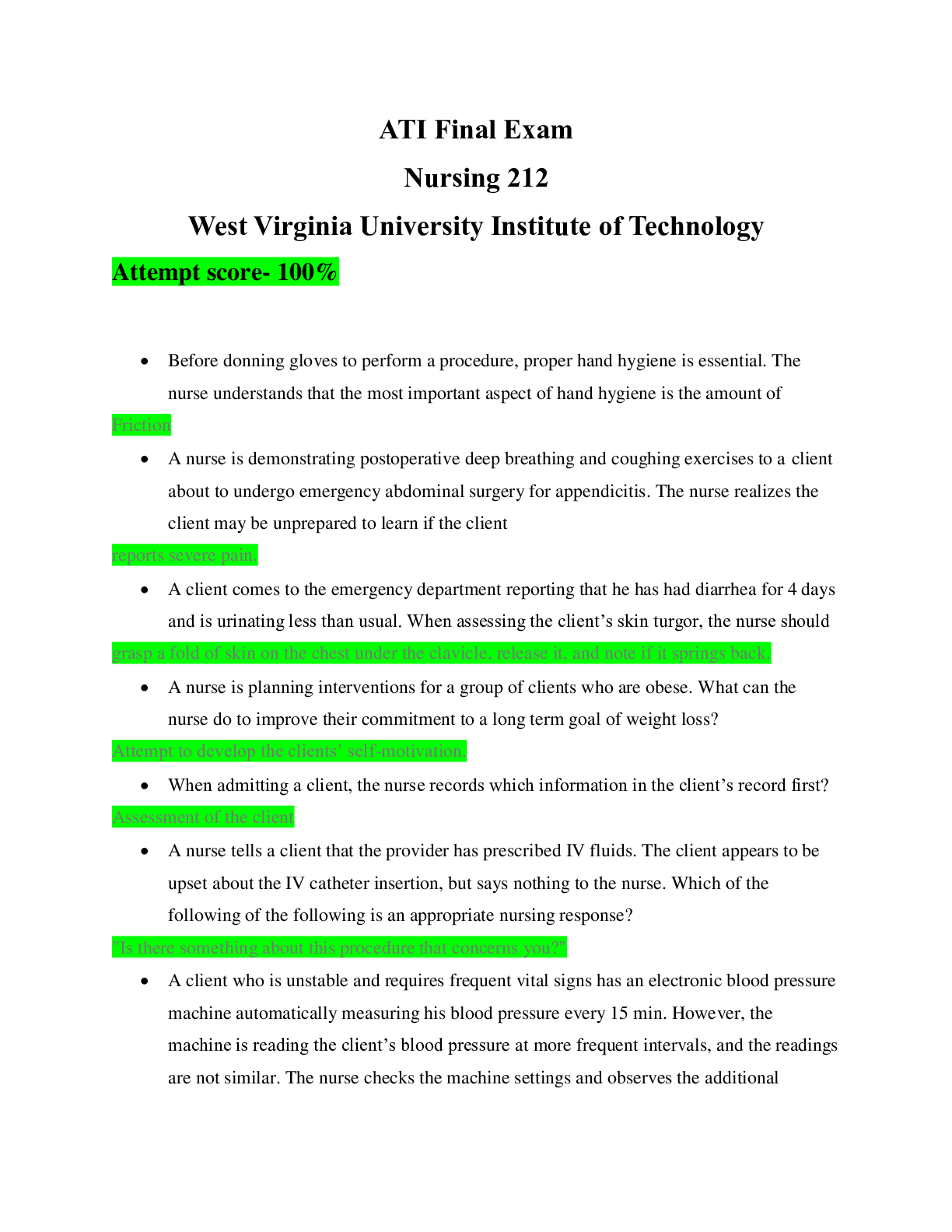NR 328 EXAM Solution Guide | Updated Summer 2025
Document Content and Description Below
Peds NR 328 Final EXAM STUDY GUIDE And Answers(Well Organized & Detailed) INTRO TO PEDIATRICS/FAMILY/CHRONIC ILLNESSES: ● Describe atraumatic care ● Identify the essential elements of the t... ransition to parenting ● Describe the role that effective discipline plays in a child’s development ● Stages of divorce ● Effects of divorce—listen to podcast again ● Discuss major stressors of hospitalized children o Developmental milestones— ● Explain the nurse’s role in minimizing these stressors ● Discuss the impact of chronic illness on the child ● Discuss how a chronic condition can affect child development ● Identify the patterns of coping of the family with a child with a chronic illness ● List nursing goals in chronic illness and discuss age-related strategies to promote growth and development and psychosocial adaptation. ● Discuss pain assessment of children ● Develop a nursing care plan for the child in pain ● Discuss non-pharmacologic and pharmacologic management of pain in children ● Genetics ● Chromosomal abnormalities ● Describe the major historical and societal changes that have had an impact on children’s health care. • Discuss the role of the pediatric nurse in acute care, outpatient, rehabilitative and community settings, and society • Describe hereditary influences on health promotion of the child and family. • Discuss therapeutic management of genetic disease. • Describe the role of nurses in genetic counseling. ● List the principles of growth and development and give examples of each ● Discuss Erikson’s stages of development, and how a nurse fosters child development through each stage ● Explain the major physiological growth and developmental characteristics of the infant, toddler, pre-schooler, schoolager, and adolescent. ● Describe the characteristic play • Discuss the impact of school on the child’s relationships with parents, siblings, peers, and other adults • Identify activities and interventions that would encourage progressive independence and responsibility ● Describe the physical maturation of the child. ● Describe the biologic developments that occur in males/females during the adolescent period • Explain the characteristics of the adolescent period that may result in family stress • Describe the components and use of the Denver Developmental Screening Test ● Identify essential growth and development milestones of infancy. • Develop a teaching plan for parents relating to normal infant care and health promotion. • Discuss the importance of nutrition and injury prevention in regard to infants. • Describe the characteristics of speech and relate them to cognitive development. ● Identify concerns related to normal growth and development. • Discuss nutrition and injury prevention ● Develop a parental teaching plan designed to promote health ● List growth and developmental characteristics ● Develop a care plan focusing on maintenance care and injury prevention. ● Describe the characteristics of cognitive development of the adolescent. RESPIRATORY ● Identify age-related differences in anatomy and physiology that impact respiratory function in children. ● Describe the nurse’s role in supporting the child undergoing evaluation of respiratory alterations. ● The Child with Acute Respiratory Tract Infection ● Describe the pathophysiology, clinical manifestations and therapeutic management of infections of the respiratory tract and related structures: ● Outline a plan of care for a child with an infection of the respiratory tract Nursing Care of the Child with a Respiratory Tract Infection ● Develop a comprehensive plan of care that includes both acute and chronic care for a child with a chronic respiratory condition IMMUNIZATIONS AND IMMUNE DISORDERS 5-8 questions ● Outline the currently recommended immunization schedule for infants through adolescence and identify factors that contradict administration of scheduled immunizations ● Describe the normal immune response and outline developmental differences in structure and function of the immunologic system. CHILDHOOD INFECTIOUS DISEASES 7-10 questions ● Demonstrate an understanding of the clinical manifestations, management, complications, and appropriate nursing care of commonly known infectious diseases listed below: ● Discuss the pathophysiology, clinical manifestations, therapeutic management and nursing strategies for a child with pediculosis and scabies ● Identify the common fungal infections and describe related nursing care. ● Describe the clinical manifestations and nursing care for a neonate with sepsis ● Discuss the nursing management of cradle cap and diaper rash ● Explain the risk factors associated with parasitic infections in children BURNS IN THE PEDIATRIC POPULATION 2-5 ● Discuss the impact of burn care on the child, family and nurses, and identify strategies for personal coping. [Show More]
Last updated: 5 months ago
Preview 9 out of 36 pages

Loading document previews ...
Buy this document to get the full access instantly
Instant Download Access after purchase
Buy NowInstant download
We Accept:

Reviews( 0 )
$10.00
Can't find what you want? Try our AI powered Search
Document information
Connected school, study & course
About the document
Uploaded On
Sep 11, 2019
Number of pages
36
Written in
Additional information
This document has been written for:
Uploaded
Sep 11, 2019
Downloads
0
Views
193























